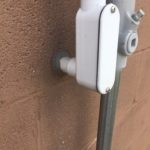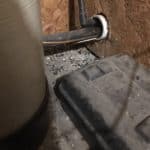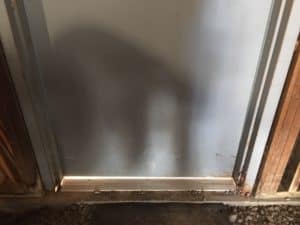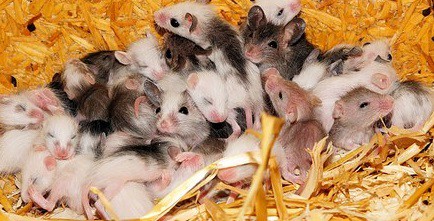How do you Keep Mice Out of Your House
Sometimes mice get into your house.
When they do, they can contaminate food, chew through wiring, wood and drywall. They are experts at traveling from one floor to another inside the walls of your home. The electrical wires and plumbing pipes are their ‘highway’. They can even crawl up the outside of a brick house. And, of course, they also freak out some family members.
Once mice are in the house, Do-It-Yourself efforts to get rid of the mice can be a long & frustrating experience.
So, why not just keep the mice out of your house? Stopping the mice before they become a problem is the first defense in mouse control. You may find yourself wondering how to keep mice out of your home.
It’s a 2-Pronged Approach:
- Make it very hard for mice to get inside of your home.
- Eliminate mouse-friendly conditions. Comfy living conditions will lead to a growing population.
Exclusion – this explains how to Mouse Proof your house or business
Exclusion is taking steps to make it hard or impossible for mice to get into a building.
Put on your detective hat & inspect the exterior of building closely. Look high & low. Look for small openings as well as larger ones. Mice can squeeze through a gap the size of a dime, so be sure to inspect closely and address any of the exclusion items below.
Why Mice can Fit through Small Holes
The first thing to understand is that mice can get through very small openings. Mice have a unique ability to flatten their ribs. A full-grown mouse can fit through a hole the size of a dime and through a 1-quarter inch gap under a door.
How to Find Where Mice are Coming into your House
- Openings where utilities enter your home such as electrical lines, water pipes, dryer vents and hose bibs. Fill gaps and openings with copper mesh. Mice can chew through caulking but not copper mesh.



*Pictured above (far right): We found this situation in a new customer’s building. Someone knew mice were coming in through the opening but, instead of sealing it off, they placed a bait station (the black box) next to the opening. Sealing it off would be a more permanent solution.
- Gaps along the bottom & sides of garage doors. Weather seals wear out and need to be replaced every few years. Also check the seals around the door edges.

- Gaps under entry doors. Install rodent door sweeps. Rodent door sweeps have a special interior fiber that rodents cannot chew through. Traditional brush and rubber door sweeps do not deter rodents from chewing and passing through the sweep.

- Open vents. Remember to look up!
- Gaps around chimney.
- Openings around window well windows.
- Tall grass or other vegetation along the foundation of your house is an ideal environment for mice. Keeping a three-foot-wide space between any vegetation and your house is a good practice. Green Giant provides Vegetation Management services to keep these areas free of hiding spots.
- Look for voids / tunneling under concrete slabs such as steps, patios and sidewalks.
- Keep trash cans tightly covered.
- Eliminate unnecessary debris. Mice like to tunnel under pieces of wood or other materials.
Are Mice Dangerous?
Yes! Mice are a human health hazard – there is no doubt about it. They may look cute and cuddly, but you really don’t want them in your house. They spread diseases through their urine, saliva and droppings (poop). Salmonellosis, hantavirus and listeria are all serious diseases that can be spread by mice. They can also start fires when they chew through wiring inside your walls. So, you should take any kind of mouse problem seriously.
 Don’t Delay – Mice multiply very fast. To put it into perspective, a family of 6 mice can multiply into 50 – 60 mice in just 90 days. And you don’t want a mouse to die in a wall.
Don’t Delay – Mice multiply very fast. To put it into perspective, a family of 6 mice can multiply into 50 – 60 mice in just 90 days. And you don’t want a mouse to die in a wall.
Where Mice Nest in Houses?
Mice nest where they are safe – so, what are mice afraid of? You! And, dogs, cats and other predators. They also do not like light.
For these reasons, mice look for dark, quiet locations to make their nests. Attics, crawl spaces, dark corners of closets and basements can provide a good habitat for mice.
Clutter provides a very safe harborage area for mice – meaning an area where they are protected from danger and adverse weather. They do not want to be out in the open. Mice navigate by rubbing against stationary objects – like walls, boxes, and many other things. If you have a lot of boxes or other items stored in a basement or attic, the mice will also use that as cover. Anything you can do to eliminate this condition will make your home less desirable to mice.
Mice in Walls
Mice in walls can be tough to control. Sometimes you will hear them, but you can’t find them. The mice will need to come out of the wall to get food, so you will need to search for the locations where they are entering and exiting the walls. There will likely be multiple exits/entrances and these are good places to set mouse traps. If you are not successful, it might be time to hire an exterminator.
What Attracts Mice to Your House?
To Stay Warm: Mice will start coming inside in the early fall when it starts to get cold. Mice will often go back & forth from inside to outside during the cold months. If we get a warm spell, the mice will venture out– then come back in when it gets cold again.
To Find Food: When it gets cold, the food supply outside decreases and mice will try to get inside your nice warm house to begin searching for food.
To search for safe, comfortable nesting locations: Hey, it’s a tough world out there – might as well come inside!
By addressing these issues, you will greatly increase your chances of denying entry to mice!
If you are interested in hearing more about Rodent Control services or any of Green Giant’s services, please contact us! We make it easy to keep mice out of your house.

Lawn Care
Green Giant Home & Commercial’s Lawn Care services control weeds, build the thickness and density of your lawn and protect it from being damaged by insects and disease, providing you with a great-looking, healthy lawn. We offer fertilization, weed control, liming, insect control, and aeration and overseeding. Visit our Lawn Care page for more information.
Tree Care
Green Giant performs: Proper Diagnosis and Treatment of Tree & Shrub Problems, Insect & Disease Control (including Spotted Lanternfly), and Nutrient Management via Deep Root Fertilization to keep your plants healthy and thriving. Visit our Tree Care page for more information.
Vegetation Management
Green Giant’s Non-Lawn Weed Control services eliminate unwanted vegetation in a wide variety of locations for both residential and large commercial/municipal properties. Areas include fence lines, around obstacles to reduce weed eating, stone/gravel driveways & parking lots, swales, roadside/curbside vegetation management and more. Find more information, visit our Vegetation Management page.
Pest Control
Our full service pest control division provides both Year-Round Service Programs that cover the vast majority of pests that you will encounter and also One-Time Corrective Services for pests such as bees, ants, termites or mice. For more information, visit our Pest Control page.